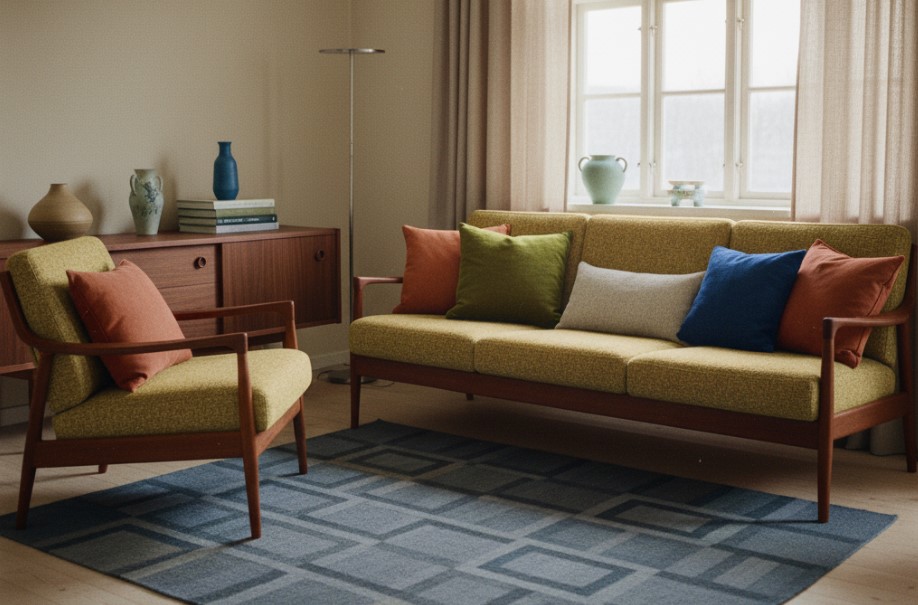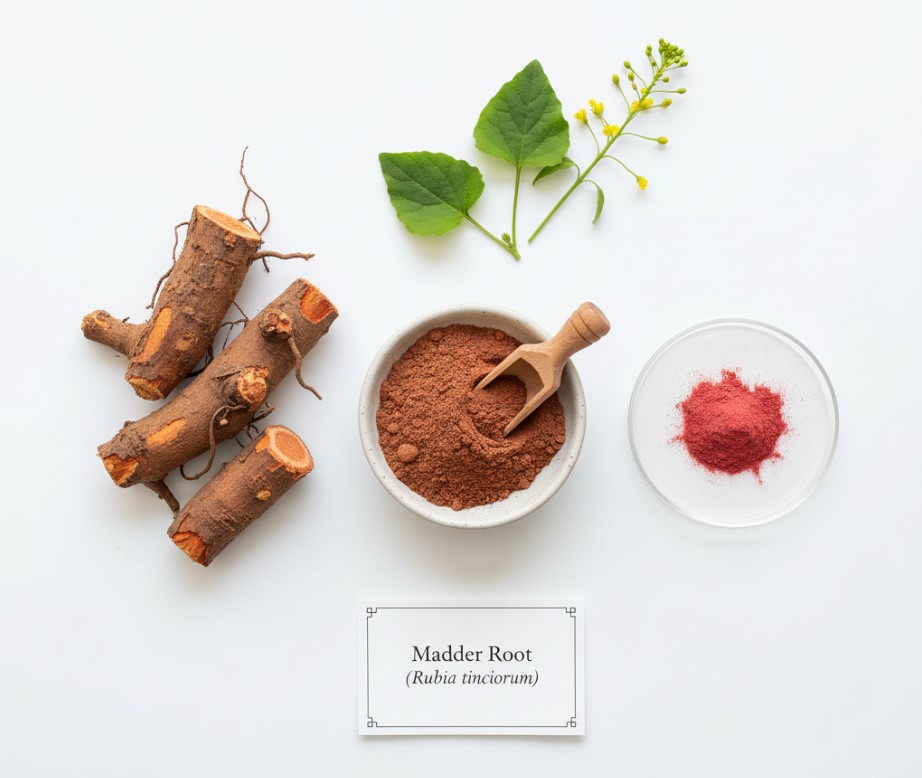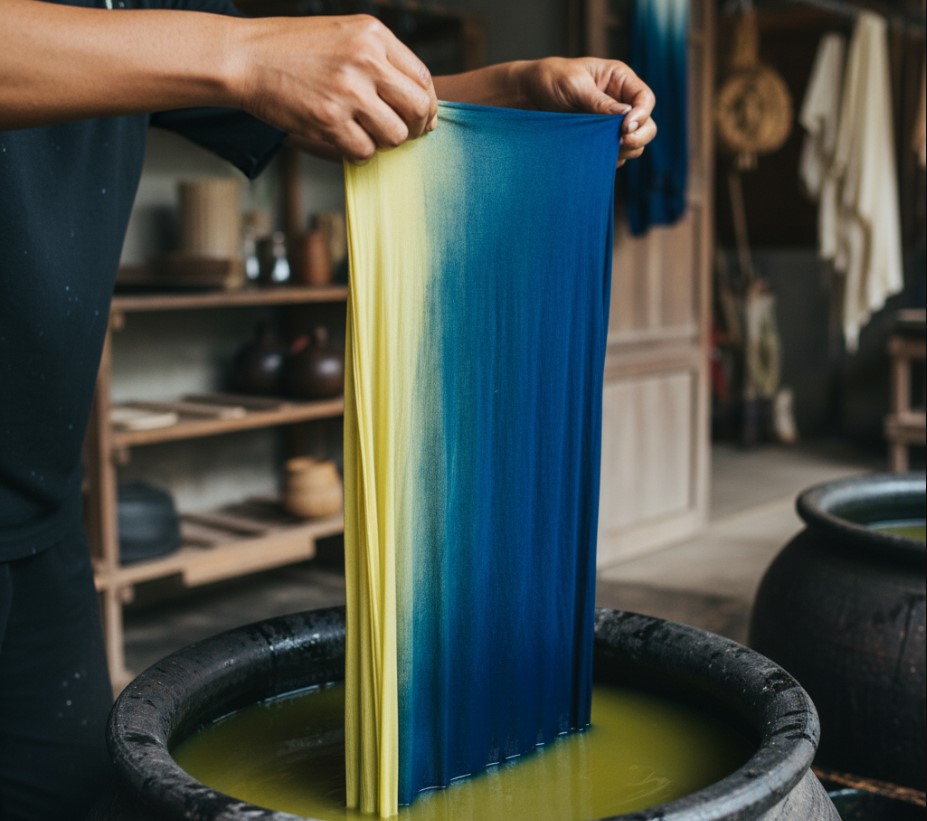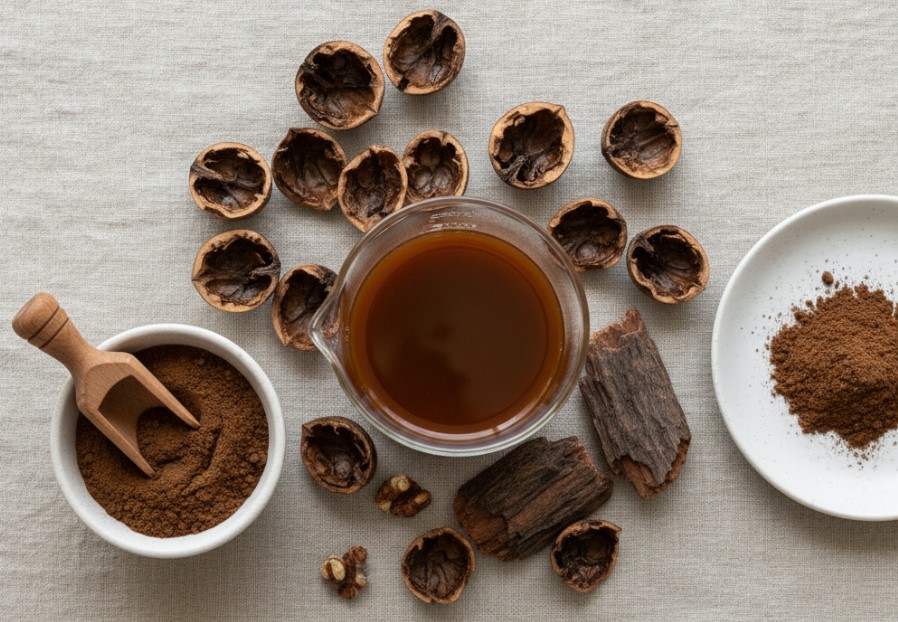Natural Dyes in Danish Modern Textiles: Madder, Indigo, and Walnut

Marie Gudme Leth, Denmark's most influential textile designer of the mid-century period (1895-1997), taught at the School of Decorative Art and shaped an entire generation's approach to textile design. Her students went on to work at companies producing fabrics for Arne Jacobsen's Egg Chair, Finn Juhl's Chieftain Chair, Hans Wegner's furniture. The color palette they used: warm earth browns, deep indigo blues, occasional madder reds. Not because these were fashionable colors, but because these were the colors natural dyes could produce reliably at commercial scale.
Here's the production reality: Synthetic dyes became available in the 1850s-1870s (mauveine in 1856, synthetic alizarin in 1869, synthetic indigo by 1897). By 1950, synthetic dyes dominated textile manufacturing globally because they cost less and produced more consistent results. But Scandinavian design philosophy emphasized material honesty and connection to nature. Using natural dyes aligned with these principles even when it meant higher costs and less predictable color matching.
The three dyes that defined Danish modern textile colors: madder root (reds and warm tones), indigo (blues), black walnut hulls (browns). Not coincidentally, these three represent different dye chemistry categories that work well on the natural fibers (wool, linen, cotton) favored in Scandinavian interiors.

Madder Root Chemistry: Alizarin and the Red-to-Brown Spectrum
Madder root (Rubia tinctorum) contains multiple anthraquinone compounds. The primary colorant is alizarin (1,2-dihydroxyanthraquinone, C₁₄H₈O₄), which produces reds. Secondary compounds include purpurin (produces oranges and yellows), pseudopurpurin, and various other anthraquinones that contribute browns and earth tones.
The challenge with madder: Getting pure red requires isolating alizarin from the other compounds. Temperature, pH, and mordanting process all affect which compounds dominate the final color. Heat the dye bath too high, and brown compounds overpower the red. Use iron mordant instead of alum, and you shift toward browns and purples. This chemical complexity explains why "Turkey Red" - a specific process developed in Anatolia for extracting clear crimson from madder - became so valued in Europe during the 18th-19th centuries.
The Turkey Red process involved pre-treating cotton with oil, then mordanting with alum plus calcium carbonate, then dyeing with madder. The oil reacted with the mordant and dye to create an exceptionally wash-fast color. European dyers trying to recreate it developed elaborate multi-step procedures including pre-treating fabric with sheep dung (to "animalize" the cellulose fibers), adding blood to dye baths, using specific water chemistry. Contemporary recipes suggest 15-20 separate steps spanning multiple days.
By the mid-20th century, this complexity made madder impractical for large-scale textile production. Synthetic alizarin, first produced commercially in 1871 by BASF, cost a fraction of natural madder and eliminated the uncertainty. The madder cultivation industry collapsed virtually overnight - what had been a major agricultural crop in France, Turkey, and India became economically unviable within a decade.
Danish textile mills in the 1950s-60s didn't use elaborate Turkey Red processes. They used simpler madder dyeing or (more commonly) synthetic alizarin to achieve warm red-brown tones that read as "natural" in finished textiles. The aesthetic remained rooted in what natural madder produced - earth tones, warm neutrals, occasional rich reds - even when the actual dye came from a chemical plant.

For textiles destined for furniture upholstery, lightfastness mattered enormously. Madder/alizarin on wool with alum mordant provides good-to-excellent lightfastness (4-5 on the Blue Wool Scale, where 8 is maximum). This made it viable for curtains, cushions, upholstery that would be exposed to years of sunlight through those large Scandinavian windows.
The typical process for wool: Mordant with 12% weight-of-fabric alum (dissolve alum in hot water, add pre-soaked wool, heat to 170°F for an hour, cool overnight). Extract madder dye by simmering ground root at 30-100% weight-of-fabric for 20-45 minutes at 140-160°F (higher temperatures extract more brown compounds). Add mordanted wool to dye bath, maintain 140-160°F for an hour, cool overnight for deeper penetration. Rinse and dry.
The color achieved depends on madder percentage: 30% WOF gives peachy-pink tones on wool, 50% WOF produces clear coral to light red, 100% WOF yields deep brick reds to burgundy depending on pH and extraction temperature. These warm tones appeared extensively in Danish textile design - not as primary colors but as accents against neutral backgrounds.
Indigo Fermentation: Bacterial Reduction and Blue Depth
Indigo presents entirely different chemistry. The colorant indigotin (C₁₆H₁₀N₂O₂) exists in plant leaves as indican, a water-soluble glucoside. Processing requires two steps: hydrolyze indican to release indoxyl, then oxidize indoxyl to form insoluble indigo pigment.
Traditional processing: Pack fresh-cut Indigofera tinctoria leaves (or Polygonum tinctorium in Japan, Isatis tinctoria/woad in Europe) into vats with water. Bacterial fermentation over 12-15 hours hydrolyzes indican into indoxyl plus glucose. Exposure to air oxidizes the indoxyl, causing it to dimerize into indigo blue pigment that precipitates out. Filter, press into cakes, dry, powder.
The dyeing process requires reduction - converting insoluble blue indigo back into soluble yellow-green leucoindigo. Traditional methods used bacterial fermentation in alkaline vats. Mix indigo pigment with organic material (wheat bran, madder root that's already been used for red dyeing, ground Indigofera leaves), lime (calcium hydroxide) for alkalinity, and water. Thermophilic anaerobic bacteria (Clostridium species primarily) generate hydrogen as metabolic product, which reduces the indigo.
The fermentation vat takes days to weeks to establish depending on temperature. Once active, it maintains itself with periodic feeding of organic material. The vat stays at pH 9.5-11 (strongly alkaline). The leucoindigo appears yellow-green below the surface. Dip fabric into the vat, it emerges yellow-green, then turns blue as air oxidizes the leucoindigo back to indigo.

Mid-century Danish textile production didn't use fermentation vats for commercial work. Too slow, too variable, required constant maintenance. Instead, they used chemical reduction with sodium hydrosulfite (Na₂S₂O₄) - dissolve indigo pigment with hydrosulfite and sodium hydroxide, instant leucoindigo solution. This method became standard worldwide after synthetic indigo entered production.
But the aesthetic reference point remained natural fermented indigo. The depth of blue achieved through multiple dips (each dip adds another layer of indigo), the slightly irregular color distribution, the way indigo sits on fiber surfaces rather than penetrating completely - these characteristics defined "good" indigo dyeing regardless of whether the vat used bacteria or sodium hydrosulfite.
Natural fermented indigo vats produce blues with subtle complexity because they contain not just indigotin but also indirubin (red tones), kaempferol (yellow), and other flavonoids. This creates richer, less monochromatic blues than pure synthetic indigo. Textile designers working in the natural dye revival (starting ~2000s) emphasize this difference - natural indigo reflects light across more of the visible spectrum, synthetic indigo reflects primarily in the blue range.
For Danish modern interiors, indigo appeared in upholstery, curtains, cushions - always as deep saturated blues that anchored rooms full of light wood and neutral tones. The blue provided necessary visual weight without introducing warm colors that would conflict with the wood tones.
The indigo dyeing process requires specific pH control and reduction management. Too much alkali damages protein fibers, too little prevents complete reduction. The fermentation chemistry involves complex bacterial ecology that textile chemists didn't fully understand until recent decades.
Walnut Hull Chemistry: Juglone as Direct Dye
Black walnut (Juglans nigra) hulls contain juglone (5-hydroxy-1,4-naphthoquinone), a naphthoquinone compound that functions as both herbicide and dye. Walnut trees evolved juglone as defense mechanism - it leaches from roots and fallen nuts, preventing competing trees from growing within 10-15 feet. This allelopathic effect makes walnut trees excellent for timber but challenging for companion planting.

Juglone oxidizes to form a brown pigment when exposed to air. This property makes walnut a substantive or direct dye - it bonds to protein fibers (wool, silk) without requiring mordant. The dye works through physical and hydrogen bonding rather than chemical reaction with mordant metals.
The characteristic walnut color: rich warm brown without strong red or yellow undertones. At 25-30% weight-of-fabric, it produces creamy coffee to milk chocolate tones. At 100% WOF with iron modifier, it yields dark chocolate to near-black browns. This neutral brown quality made walnut exceptionally useful for Scandinavian textiles where warm earth tones dominated.
Processing walnut hulls: Collect green hulls when nuts fall (late summer/early autumn). Fresh hulls contain maximum juglone. Dried hulls work but have reduced dye content. Soak whole hulls in water for 2-3 days minimum - juglone extraction improves with time. The soaking liquid turns deep brown. Strain out solids, use the liquid as dye bath.
For dyeing wool: Add wool to walnut dye bath, heat to 180°F, simmer 1-2 hours. The brown develops primarily during cooling as juglone continues oxidizing. Remove wool when desired shade achieved. No mordant necessary, though alum pre-mordanting slightly deepens color and improves lightfastness.
Walnut works less effectively on cellulose fibers (cotton, linen) without tannin pre-treatment and alum mordanting. The natural fiber properties affect dye uptake significantly - protein fibers accept walnut readily, cellulose requires additional processing.
The warm browns from walnut appeared throughout Danish modern interiors - upholstery fabrics, curtains, wool blankets, woven textiles. These browns worked harmoniously with teak, rosewood, oak furniture because they came from similar organic chemistry. The visual coherence of natural materials dyed with natural colorants created aesthetic unity that synthetic dyes struggled to replicate.
Iron modifiers with walnut produce interesting shifts. Add ferrous sulfate (iron(II) sulfate) to the dye bath or apply as after-bath, and juglone complexes with iron to create blue-black to charcoal tones. This technique appears in some Danish textiles where darker accents were needed without introducing fully black colors that would feel harsh against warm wood tones.
Production Economics: Why Natural Dyes Persisted
By 1960, synthetic dyes cost substantially less than natural alternatives. Synthetic alizarin: $2-3 per pound. Natural madder root: $8-15 per pound with lower dye yield. Synthetic indigo: $4-6 per pound. Natural indigo: $15-30 per pound. The economic case for synthetics seemed overwhelming.
But several factors kept natural dyes viable in Scandinavian textile production through the mid-century period:
Brand positioning: "Danish modern" as aesthetic category emphasized natural materials, handcraft tradition, connection to nature. Using natural dyes aligned with brand identity even at higher cost. Consumers purchasing Jacobsen or Wegner furniture expected textiles that matched the same ethos.
Color palette compatibility: The specific colors natural dyes produced - those warm browns, deep blues, earth reds - suited mid-century interiors better than the brighter, more saturated colors synthetic dyes could achieve. Natural dyes gave designers the palette they wanted without requiring custom synthetic dye formulations.
Small-batch production: Danish furniture manufacturers produced relatively small quantities compared to mass-market furniture. Textile runs might be hundreds of yards rather than thousands. Natural dye processes scaled reasonably well to small batch sizes where synthetic dye infrastructure (which optimizes for huge runs) showed less advantage.
Lightfastness acceptable: For interior textiles not exposed to harsh direct sunlight, natural dyes offered sufficient lightfastness. Scandinavian interiors typically featured diffuse northern light rather than intense southern exposure. Curtains and upholstery lasted years without significant fading.
Labor cost context: Denmark and Sweden had relatively high labor costs but strong craft traditions. The additional labor for natural dyeing represented smaller percentage increase in total production cost than in countries with cheaper labor.
The Danish Design Council's 2017 "Danish Design DNA" identified durability, craftsmanship, and social consciousness as core values. These principles emerged directly from mid-century design philosophy that valued natural dyes as more durable and crafted than synthetic alternatives.
Scandinavian Textile Designers and Natural Dye Aesthetic
Marie Gudme Leth drew inspiration from Danish flora and international travels to create nature-inspired prints. Her teaching emphasized understanding plant materials and natural color palettes. Students learned not just design but the material reality of how textiles get colored - the mordanting, the dye extraction, the variables affecting final results.
Verner Panton (1926-1998) represents the opposite pole - bold synthetic colors, plastic materials, rejection of natural material constraints. His Mira Spectrum textile series featured saturated geometric patterns in colors impossible to achieve with natural dyes. This represented the mod/space age direction mid-century design could take.
The tension between these approaches - Leth's nature-inspired natural colors versus Panton's synthetic vibrancy - played out across Scandinavian design. Both coexisted in the market. Finn Juhl's furniture might feature either natural-dyed wool in earth tones or bright synthetic textiles depending on client preferences.
Marimekko in Finland (founded 1951) eventually dominated the bold-color end of the market with synthetic dyes creating their signature saturated prints. But Danish manufacturers like Kvadrat (founded 1968) maintained natural-dye-influenced color palettes even when using synthetic dyes, demonstrating that the aesthetic had become independent of the actual chemistry.

The natural dye mordants used in textile production create specific color characteristics that trained eyes recognize. Alum mordant on madder produces different reds than tin mordant. Iron shifts colors toward blue-black or brown-black. Color sources beyond the three discussed here - weld for yellows, cochineal for bright reds, logwood for purples - expanded the available palette but never displaced madder, indigo, and walnut as foundations.
Contemporary Context: Natural Dye Revival
The past 20 years saw substantial renewed interest in natural dyeing, driven by environmental concerns about synthetic dye production (toxic waste streams, heavy water usage, petroleum-based chemistry) and desire for artisanal production methods.
Contemporary natural dye suppliers like Botanical Colors, Maiwa, and others provide processed extracts that simplify the traditional methods while maintaining natural dye aesthetics. Madder root now comes as finely ground powder rather than requiring hours of extraction. Indigo paste eliminates fermentation vat management. Walnut hull powder standardizes what was previously a foraged material.
These processed forms make natural dyeing accessible to small studios and craft practitioners but represent compromise with tradition. The natural dye resist techniques that create patterns rely on understanding how specific dyes penetrate fibers. The natural dyeing equipment required for proper mordanting and dyeing hasn't changed fundamentally - still need stainless pots, accurate thermometers, pH meters, proper ventilation.
Commercial textile mills largely continue using synthetic dyes because economics still favor them. But natural-dye-inspired color palettes persist. The warm browns, deep blues, earth reds that natural dyes produced became defining characteristics of "Scandinavian" or "Nordic" aesthetics. Contemporary textile designers reference these colors whether or not actual natural dyes are involved.
The aesthetic succeeded independent of the chemistry. This represents both loss and continuity - loss of material connection between color source and final textile, continuity of visual language that communicates "natural," "handcrafted," "connected to earth."
Technical Documentation: Process Specifications
Achieving consistent results with natural dyes requires careful attention to variables:
Water quality: Hard water (high calcium/magnesium) affects dye uptake. Soft water or rainwater gives more predictable results. Many traditional dye recipes specify using particular water sources because preindustrial dyers understood water chemistry affected outcomes even before understanding why.
Fiber preparation: Protein fibers (wool, silk) generally require just mordanting. Cellulose fibers (cotton, linen) benefit from tannin pre-treatment before mordanting - the tannin helps mordant bond to fiber. The natural fiber properties determine optimal preparation sequence.
Temperature control: Each dye has optimal extraction and dyeing temperatures. Too low: incomplete dye extraction or bonding. Too high: fiber damage or unwanted color shifts. Madder extracted above 180°F pulls more brown compounds, shifting color toward brick red rather than clear crimson. Indigo fermentation vats maintain 75-85°F for optimal bacterial activity.
pH management: Madder extraction works best slightly acidic to neutral (pH 6-7). Indigo vats require strong alkalinity (pH 9.5-11). Walnut accepts wide pH range but slightly acidic (pH 5-6) produces cleanest browns. Having accurate pH measurement matters for professional results.
Mordant ratios: Standard alum mordant uses 12% weight-of-fabric for protein fibers, 15% for cellulose after tannin treatment. Too little: weak color and poor lightfastness. Too much: harsh feel on fabric, wasted material.
Dye concentration: Madder 30-100% WOF depending on desired depth. Indigo requires multiple dips rather than single long immersion - each dip adds layers. Walnut 25-100% WOF with iron modifier at 2-4% WOF for darkest browns.
These specifications represent decades of accumulated knowledge. Textile chemists in the early 20th century systematically documented optimal conditions for natural dyes just as synthetics were displacing them. This documentation allowed later natural dye revivals to skip much trial-and-error.
The Material Philosophy
Danish modern's embrace of natural dyes reflected broader philosophical commitments. Kaare Klint (1888-1954), considered the father of Danish furniture design, emphasized understanding materials deeply - studying historical furniture to learn classical proportions, testing wood strength systematically, considering how bodies actually interact with chairs. This analytical approach to materials extended to textiles.
Natural dyes fit this philosophy because working with them required understanding plant chemistry, fiber structure, mordant reactions. Using synthetics meant accepting industrial chemistry as black box - buy dye powder, follow instructions, get color. Natural dyes demanded engagement with material reality.
This distinction matters less now that both natural and synthetic dyes are equally mysterious to most users. Contemporary textile designers can specify Pantone colors without understanding any dye chemistry. The material engagement that mid-century designers practiced has largely disappeared from industrial production.
But it persists in craft communities. People dyeing with madder root or indigo vats today engage with the same material challenges 1950s Danish textile mills faced. The colors emerge from understanding plant chemistry, fiber preparation, timing, temperature. This connects contemporary craft practitioners to historical traditions in ways synthetic dyes can't replicate.
The warm browns, deep blues, and earth reds of Danish modern textiles weren't arbitrary aesthetic choices. They emerged from specific plant chemistry that Scandinavian textile producers could source and process reliably. That these colors harmonized perfectly with teak and rosewood furniture came from both being natural materials following similar chemical principles. The visual coherence of mid-century interiors reflected underlying material coherence - everything from wood to textiles to ceramics followed natural organic chemistry rather than synthetic industrial processes.
This material approach to design - understanding why things look the way they do based on how they're made - represents mid-century modernism's most lasting contribution. Whether working with natural or synthetic materials today, the principle persists: honest materials expressing their actual properties create more lasting design than materials pretending to be something they're not.